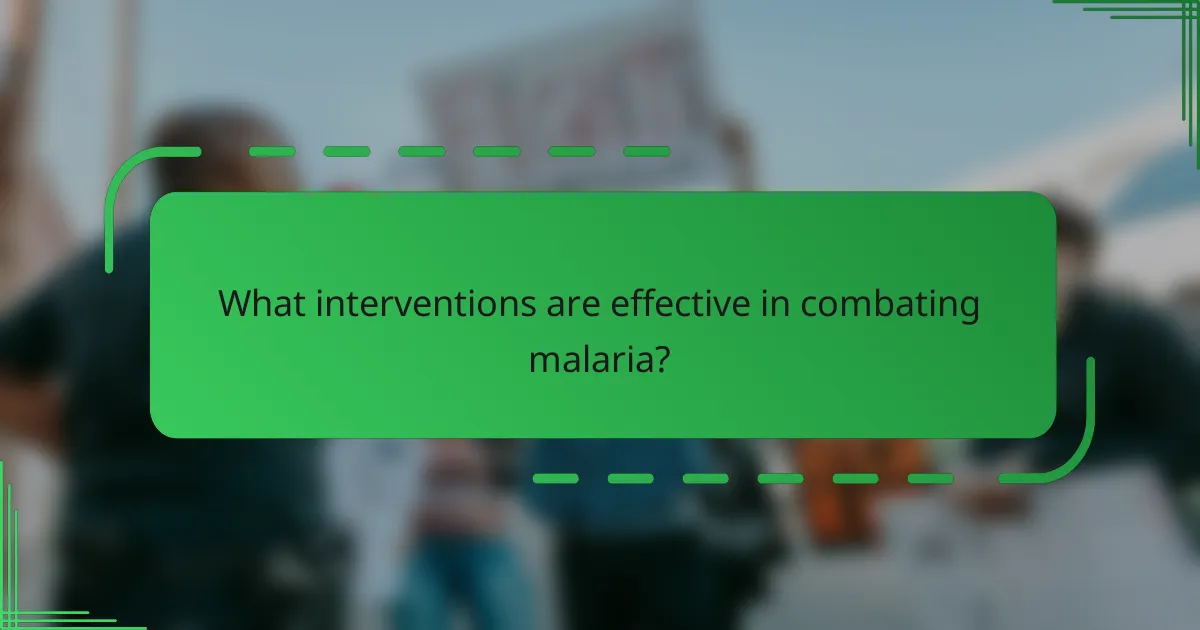Malaria poses a severe challenge to Nigerian communities, resulting in millions of cases each year and contributing to high morbidity and mortality rates. This disease not only threatens the health of vulnerable populations but also disrupts economic stability by increasing healthcare costs and reducing productivity. The cumulative impact of malaria hinders overall community development and growth, making it a critical public health concern in Nigeria.

How does malaria affect health outcomes in Nigerian communities?
Malaria significantly impacts health outcomes in Nigerian communities, leading to increased illness and death, particularly among vulnerable populations. The disease contributes to a high burden of morbidity and mortality, affecting overall community health and economic stability.
Increased morbidity rates
Malaria is a leading cause of illness in Nigeria, with millions of cases reported annually. The disease often results in symptoms such as fever, chills, and fatigue, which can hinder daily activities and productivity.
In rural areas, where access to healthcare is limited, the burden of malaria can lead to chronic health issues. Frequent infections may weaken the immune system, making individuals more susceptible to other diseases.
High mortality rates among children
Children under five years old are particularly vulnerable to malaria, with a significant proportion of malaria-related deaths occurring in this age group. In Nigeria, it is estimated that malaria accounts for a substantial percentage of child mortality, contributing to the high infant mortality rate.
Efforts to reduce child mortality from malaria include increasing access to preventive measures such as insecticide-treated nets and prompt treatment. However, challenges remain in reaching all communities effectively.
Long-term health complications
Survivors of severe malaria may experience long-term health complications, including anemia and cognitive impairments. These complications can affect educational outcomes and future economic opportunities for affected individuals.
Additionally, recurrent malaria infections can lead to chronic health issues, further straining healthcare resources and impacting community well-being. Addressing these long-term effects is crucial for improving health outcomes in Nigerian communities.

What are the economic effects of malaria in Nigeria?
The economic effects of malaria in Nigeria are significant, impacting productivity, healthcare costs, and agricultural output. These factors collectively hinder economic growth and development in affected communities.
Loss of productivity in the workforce
Malaria leads to considerable loss of productivity in Nigeria’s workforce due to illness and absenteeism. Workers suffering from malaria may miss several days of work, which disrupts operations and reduces overall output.
Estimates suggest that malaria can reduce productivity by tens of percent in sectors heavily reliant on manual labor, such as construction and manufacturing. Employers often face increased costs to cover for absent workers, further straining resources.
Increased healthcare costs
The burden of malaria significantly raises healthcare costs for families and the government in Nigeria. Individuals often spend a substantial portion of their income on treatment, which can lead to financial hardship.
On a national level, the government allocates considerable funds to combat malaria, including prevention and treatment programs. These expenses can divert resources from other critical health initiatives, affecting overall healthcare delivery.
Impact on agricultural output
Malaria adversely affects agricultural output in Nigeria, as many farmers are unable to work during peak seasons due to illness. This results in lower crop yields and reduced food security for communities.
Farmers suffering from malaria may also face challenges in managing their farms effectively, leading to decreased productivity. The economic ripple effects can include higher food prices and increased reliance on imports, further impacting local economies.

What statistics illustrate malaria’s impact in Nigeria?
Malaria significantly affects Nigerian communities, with millions of cases reported annually. The disease contributes to high morbidity and mortality rates, impacting health systems and economic productivity across the nation.
Annual infection rates
Nigeria accounts for a substantial portion of malaria cases globally, with estimates suggesting that there are over 50 million infections each year. This high infection rate places a considerable burden on healthcare resources and highlights the urgent need for effective prevention and treatment strategies.
In recent years, efforts to control malaria have led to some fluctuations in infection rates, but the overall prevalence remains alarmingly high, particularly in rural areas where access to healthcare is limited.
Demographic distribution of cases
Malaria affects various demographic groups in Nigeria, with children under five and pregnant women being the most vulnerable. These populations experience higher rates of severe illness and complications, contributing to increased mortality rates.
Additionally, socioeconomic factors play a significant role in the distribution of malaria cases, with lower-income communities facing greater challenges in accessing preventive measures such as insecticide-treated nets and antimalarial medications.
Regional prevalence variations
There are notable regional variations in malaria prevalence across Nigeria, with the northern regions generally experiencing higher rates compared to the south. Factors such as climate, population density, and healthcare infrastructure contribute to these differences.
For instance, states like Kano and Jigawa report some of the highest infection rates, while southern states like Lagos and Rivers have implemented more effective control measures, resulting in lower prevalence. Understanding these regional disparities is crucial for targeted interventions and resource allocation.

What interventions are effective in combating malaria?
Effective interventions for combating malaria include the distribution of insecticide-treated nets, community health education programs, and access to antimalarial medications. These strategies work together to reduce transmission rates and improve health outcomes in affected communities.
Distribution of insecticide-treated nets
Insecticide-treated nets (ITNs) are a primary defense against malaria, providing a barrier between individuals and mosquitoes. Communities should aim for universal coverage, ensuring that every household has access to at least one ITN for each sleeping space.
Regular distribution campaigns, often supported by government and non-governmental organizations, can significantly increase the availability of ITNs. It is crucial to educate families on the proper use and maintenance of these nets to maximize their effectiveness.
Community health education programs
Community health education programs play a vital role in raising awareness about malaria prevention and treatment. These programs should focus on teaching individuals about the symptoms of malaria, the importance of seeking prompt medical care, and preventive measures such as using ITNs and indoor residual spraying.
Engaging local leaders and health workers in these educational initiatives can enhance their credibility and reach. Regular workshops and informational sessions can help reinforce knowledge and encourage community participation in malaria control efforts.
Access to antimalarial medications
Ensuring access to effective antimalarial medications is critical for treating infected individuals and preventing severe health outcomes. Communities should work towards establishing reliable supply chains for these medications, making them available at local health facilities and pharmacies.
Additionally, it is important to promote the use of rapid diagnostic tests to confirm malaria cases before treatment. This helps avoid the misuse of medications and contributes to better health outcomes and reduced drug resistance.

How do socioeconomic factors influence malaria prevalence in Nigeria?
Socioeconomic factors significantly impact malaria prevalence in Nigeria, affecting both the likelihood of infection and the effectiveness of treatment. Communities with lower income levels, limited education, and poor living conditions are more vulnerable to malaria outbreaks.
Income levels and access to healthcare
Income levels directly influence access to healthcare services in Nigeria. Households with higher incomes are more likely to afford preventive measures, such as insecticide-treated bed nets and antimalarial medications. In contrast, low-income families often struggle to access these essential resources, increasing their risk of malaria.
Moreover, wealthier communities typically have better healthcare facilities and trained personnel, leading to improved diagnosis and treatment outcomes. This disparity highlights the importance of economic stability in combating malaria effectively.
Education and awareness
Education plays a crucial role in malaria prevention and treatment in Nigeria. Communities with higher educational attainment tend to have better awareness of malaria transmission and prevention methods. This knowledge enables individuals to take proactive measures, such as using mosquito nets and seeking prompt medical attention.
Conversely, lower education levels often correlate with misconceptions about malaria, leading to inadequate responses to symptoms and delayed treatment. Increasing educational initiatives can significantly reduce malaria prevalence by empowering communities with the necessary knowledge.
Living conditions and sanitation
Poor living conditions and inadequate sanitation are key contributors to malaria prevalence in Nigeria. Areas with stagnant water, which serve as breeding grounds for mosquitoes, are more likely to experience higher infection rates. Improving drainage systems and sanitation facilities can help mitigate these risks.
Additionally, overcrowded living environments can facilitate the spread of malaria. Ensuring proper housing and community planning can reduce the incidence of malaria by limiting mosquito exposure and enhancing overall health outcomes.

What role does government policy play in malaria control?
Government policy is crucial in malaria control as it shapes funding, resource allocation, and strategic initiatives. Effective policies can enhance prevention, treatment, and education efforts, ultimately reducing malaria’s prevalence and impact on communities.
Funding for malaria programs
Government funding is essential for sustaining malaria control programs, including prevention and treatment initiatives. Allocating budgetary resources towards insecticide-treated nets, antimalarial medications, and community health education can significantly decrease malaria transmission rates.
In Nigeria, government budgets often reflect international support and partnerships, which can enhance local efforts. For instance, collaboration with organizations like the Global Fund can amplify funding and improve program effectiveness.
Implementation of health policies
Health policies must be effectively implemented to combat malaria. This includes establishing guidelines for diagnosis, treatment protocols, and preventive measures such as vaccination campaigns and vector control strategies.
Regular training for healthcare workers is vital to ensure adherence to these policies. Community engagement is also important, as local populations need to understand and trust the measures being implemented for them to be effective.
Monitoring and evaluation
Monitoring and evaluation are critical components of malaria control policies. Governments should regularly assess the effectiveness of their programs through data collection and analysis to identify areas for improvement.
Utilizing health information systems can help track malaria cases and treatment outcomes, allowing for timely adjustments to strategies. This data-driven approach ensures that resources are used efficiently and effectively to combat malaria in Nigerian communities.



